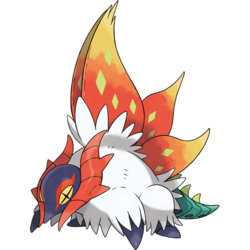From Bulbapedia, the community-driven Pokémon encyclopedia.

|
The subject of this article is a Pokémon which has recently been announced.
This article's contents will change as more information becomes available, perhaps abruptly. Please be cautious when adding information to this article, as rumors and speculation can often be confused with facts. Avoid any information on this subject which is not confirmed by reliable sources.
|
Slither Wing (Japanese: チヲハウハネ Chiohauhane) is a dual-type Bug/Fighting Paradox Pokémon introduced in Generation IX.
While it is not known to evolve into or from any other Pokémon, it appears to be an ancient relative of Volcarona.
Biology
Slither Wing is a large, moth-like Pokémon with four legs. It appears to have compound eyes that are two shades of red, and there is a red spiny horn-like structure on each side of its face. The fuzz on its body and legs is smoky white and tangled. Its abdomen is black in the center and light blue with black dots on the outside. It has six leaf-like wings that are orange in color with yellow-orange tips and have small yellow diamond-shaped marks; they do not seem to be strong enough to allow it to fly.
It somewhat resembles an ancient form of Volcarona that was introduced in a dubious magazine. It is said to share traits with Volcarona and its name came from a similarly described creature in the Scarlet Book. There has been rare sightings of Slither Wing. Its is believed Slither Wing may have been revived from a fossil from a prehistoric era, despite no fossil evidence.
In the anime
Major appearances
Minor appearances
In the manga
In the TCG
- Main article: Slither Wing (TCG)
Game data
Pokédex entries
| This Pokémon was unavailable prior to Generation IX.
|
| Generation IX
|
|
|
Paldea
#380
|
| Scarlet
|
This mysterious Pokémon has some similarities to a creature that an old book introduced as Slither Wing.
|
| Violet
|
This Pokémon somewhat resembles an ancient form of Volcarona that was introduced in a dubious magazine.
|
|
|
Game locations
| This Pokémon was unavailable prior to Generation IX.
|
|
|
In side games
Held items
Stats
Base stats
| Stat
|
Range
|
| At Lv. 50
|
At Lv. 100
|
85
|
|
145 - 192
|
280 - 374
|
135
|
|
126 - 205
|
247 - 405
|
79
|
|
75 - 144
|
146 - 282
|
85
|
|
81 - 150
|
157 - 295
|
105
|
|
99 - 172
|
193 - 339
|
81
|
|
77 - 146
|
150 - 287
|
Total: 570
|
Other Pokémon with this total
|
- Minimum stats are calculated with 0 EVs, IVs of 0, and (if applicable) a hindering nature.
- Maximum stats are calculated with 252 EVs, IVs of 31, and (if applicable) a helpful nature.
|
Type effectiveness
| Under normal battle conditions in Generation IX, this Pokémon is:
|
|
|
|
|
|
|
|
|
|
|
|
|
Learnset
|
|
|
|
- Bold indicates a move that gets STAB when used by Slither Wing
- Italic indicates a move that gets STAB only when used by an Evolution of Slither Wing
|
|
|
|
|
- Bold indicates a move that gets STAB when used by Slither Wing
- Italic indicates a move that gets STAB only when used by an Evolution or an alternate form of Slither Wing
|
|
|
|
|
- Moves marked with an asterisk (*) must be chain bred onto Slither Wing
- Bold indicates a move that gets STAB when used by Slither Wing
- Italic indicates a move that gets STAB only when used by an Evolution of Slither Wing
|
Side game data
Evolution
Sprites
Trivia
- Currently, out of all Paradox Pokémon, Slither Wing is tied with Iron Moth for having the smallest increase in base stat total from its apparent relative, with an increase of 20 points.
- This Pokémon shares it’s name with the Slitherwing, a poisonous snake-like dragon from the How To Train Your Dragon franchise.
Origin
Name origin
Slither Wing is literally slither wing.
Chiohauhane can be taken literally as 地を這う羽 chi o hau hane (wings slithering on the ground).
In other languages
| Language
|
Title
|
Meaning
|
 Japanese Japanese
|
チヲハウハネ Chiohauhane
|
From 地を這う羽 chi o hau hane
|
 French French
|
Rampe-Ailes
|
From ramper and ailes
|
 Spanish Spanish
|
Reptalada
|
From reptar and alada
|
 German German
|
Kriechflügel
|
From kriechen and Flügel
|
 Italian Italian
|
Alirasenti
|
From ali and rasenti
|
 Korean Korean
|
땅을기는날개 Ttang-eulgineunnalgae
|
From 땅을기는날개 ttang-eulgineun nalgae
|
 Mandarin Chinese Mandarin Chinese
|
爬地翅 Pádìchì
|
From 爬 pá, 地 dì, and 翅 chì
|
 Cantonese Chinese Cantonese Chinese
|
爬地翅 Pàhdeihchi
|
From 爬 pàh, 地 deih, and 翅 chi
|
|
|
|
|
|
|
|
Related articles
External links

|
This Pokémon article is part of Project Pokédex, a Bulbapedia project that aims to write comprehensive articles on each Pokémon species, as well as Pokémon groups and forms.
|



